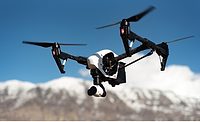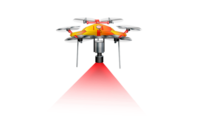Deploying drones to deliver defibrillators
Drones have a promising future for medical deliveries.

Healthcare has advanced beyond our imagination - what was once thought of as impossible, is now made possible due to rapid advances in technology. Let's take the case of defibrillators; these are devices that can restore a normal heartbeat by sending an electric pulse. They are used to prevent or correct an arrhythmia, a heartbeat that is uneven or that is too slow or too fast. A study by the American Red Cross states the average response time for traditional first responders once 911 is called, is 8 to 12 minutes. For every minute that defibrillation is delayed, survival decreases by 7 to 10%.
Among the advanced equipment found in today's ambulance, automated external defibrillators (AED) are one of the most important. If the AEDs reach a patient in time, the chances of survival increase exponentially. But for the AEDs to reach the person who is in dire need, there are many obstacles such as heavy traffic, poor road conditions, lack of situational awareness, etc.
A solution to overcome these problems is to use a drone network that can deliver AEDs and other medical supplies to patients, in a safe, efficient way.
Problems with the accessibility of AEDs
Studies have shown that many adults can survive cardiac arrest even if defibrillation is performed as late as 8 to 12 minutes after sudden cardiac arrest, particularly if CPR is provided. The so-called ‘golden hour’ is critical i.e. the patients who need attention need it within the first hour after a heart attack. Lack of speed in delivering the right solution can drastically increase the chances of death.
Another important factor is the location of the AEDs. According to a study conducted in a multidisciplinary healthcare and academic community, approximately 80% of the study population declared they had no knowledge of the location of the AED within the building where they received the majority of their education. This was a consistent finding across all the healthcare disciplines. If only the healthcare professionals knew where the AEDs were kept, they could respond.
Deploying drones at your facilities
AEDs are sophisticated, portable, and easy to use. There are continuous training sessions available for people to learn how to use the AED device, but because of the timely access to such equipment, many patients lose their lives. This is where drones come into the picture - as an ideal solution for healthcare facilities, first responders and corporations with large and multiple facilities and remote areas.
Drones have been used to deliver goods and other essential elements, and they can be used to deliver AEDs to those in need, right at the time of need. Since drone technology can be made available 24/7, there is no time lost in emergency situations.
A study title Optimizing a Drone Network to Deliver Automated External Defibrillators was conducted where a region was specified with 81 bases and 100 drones would be required to deliver an AED ahead of the median 911 response time by 3 minutes.
A single coordinated drone network across all regions required 39.5% fewer bases and 30.0% fewer drones to achieve similar AED delivery times.
First responders and healthcare companies can deploy such fleets with available software that provide features such as AI detection, precision landing and geo-fencing, to help the drone to go to the correct location, identify the victim and provide the needed kits.
Drones can also provide video of how AEDs should be performed, along with the equipment, enabling bystanders to participate in the medical help needed. With a cloud-connected fleet management system, drones can be easily deployed in most geographical settings with relatively low operational costs, compared with helicopters or road transport.
Integrating Fleet Management
A fleet management system allows operators to manage and control many drones from a single dashboard. Drones are connected to the system either using a mobile app or by installing a single board computer on a drone.
A fleet management system can reduce delays in AED delivery, by leveraging the following features:
- Advanced mission planning for creating the routes of the drones, so that the drones can fly autonomously to places where they are required.
- Live tracking on a map, so that the operator can monitor the activity of every drone in a mission.
- Live video streaming, so that the operator can have a live visual of a situation and even instruct someone close to the drone on how to use the AED.
- AI-features like precision landing so that a drone can land safely even in densely populated areas.
Drones, as a means of transport of AEDs to remote places, can also be integrated with 911 emergency response or disaster response systems. No matter where emergency medical help is needed, be it in a traffic jam, on a high-rise balcony, or at home or in the middle of a remote national park or in a rural location, if there’s a 4G/LTE/5G network, a drone-delivered AED can provide medical equipment to potentially save lives.
Looking for a reprint of this article?
From high-res PDFs to custom plaques, order your copy today!






